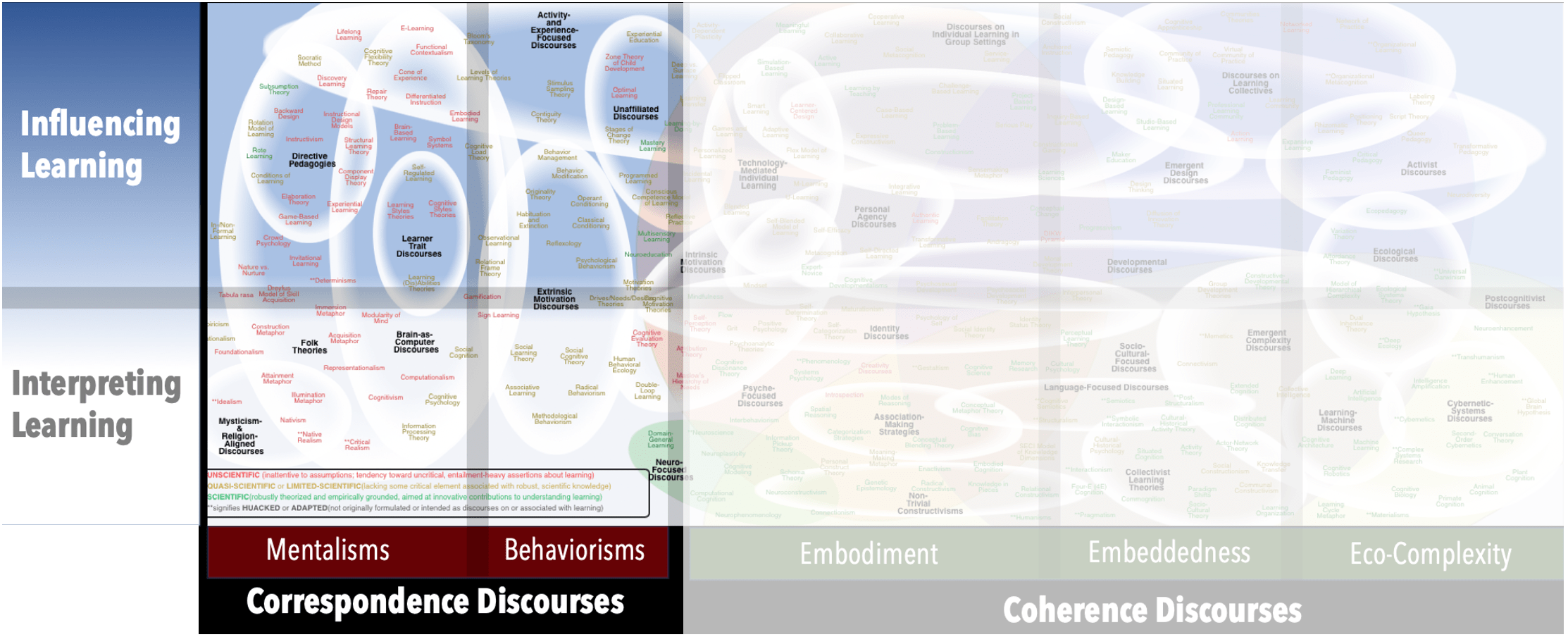AKA
Correspondence Theories of Truth
Focus
Correspondence between objective fact and subjective understandingPrincipal Metaphors
The specific metaphors of Correspondence Discourses vary from one theory to the next. However, broadly speaking, they tend to cluster around the following:- Knowledge is … external, objective truth
- Knowing is … internal, subjective understanding
- Learner is … a mental entity in a physical body
- Learning is … internalizing
- Teaching is … transmitting
Originated
Ancient (entrenched in the language)Synopsis
Correspondence Discourses are perspectives on learning that assume a radical separation of mental (or internal, or brain-based) and physical (or external, or body-based) – otherwise known as:- Dualism (Cartesian Dualism; Psychophysical Dualism) (René Descartes, 1530s) – the suggestion that the universe comprises two distinct types of substance:
- res extensa – extended, space-occupying, divisible substance, which includes that body
- res cogitans – thinking, not-space-occupying substance, which includes the mind
- Ghost in the Machine (Gilbert Ryle, 1940s) – a phrase coined as a critique of Cartesian Dualism, whereby the mind is frames as a nonphysical “ghost” that occupies a mechanical body
- Mind–Body Problem (Body–Mind Problem; Mind Control) – confusions, incongruities, and paradoxes that arise from the assumption that the mind and body are separate phenomena. Associated constructs include:
- Problems of Interaction (Mental Causation) – regarding the Mind–Body Problem, the particular conundrums around an immaterial mind or soul (with no mass, location, or shape) might compel a physical body to move
- Mind-Brain Identity Theory (U.T. Place, 1950s) – the perspective that “mind” and “brain” are the same – that is, that “state of mind” can be equated to “physical state of the brain.” While seeming to address the assumed dichotomy of the Mind–Body Problem (see above), Mind-Brain Identity Theory relies on a cluster of other dichotomies, such is internal/external, individual/collective, and self/other.
- Parallelism – Starting with the (problematical) assumption that the mind and body occupy separate realities, Parallelism is the suggestion that they operate in a such a well-coordinated fashion that they can appear to be in unison or to be a unity.
- Logical Atomism (Bertrand Russell, 1920s; Ludwig Wittgenstein, 1920s) – the view that knowledge is the totality of discrete and non-reducible (i.e., atomistic) facts
- Mechanistic Theory (Mechanical Concept of Mind; Mechanistic Approach; Mechanical-Man Concept) – the notion that human functioning, including consciousness and sociality, can be understood in terms of mechanical processes – that is, that physics is sufficient for making sense of human activity
- Reification (Concretism; Hypostatization; Objectification) – the conceptual shift involved when an abstract phenomenon (e.g., event, thought, concept, value, belief) comes to be treated as a physical object – that is, a form that one might infer is stable and knower-independent, and something that can be acquired, shaped, manipulated, measured, relayed, etc.
- Literalization (Dead Metaphor) (Richard Rorty, 1980s) – the rendering literal of a figurative device, in a way that makes it difficult to be conscious of or to recover the original figurative meaning.
- Replacement Theory – a descriptive term, used across many disciplines, that can be applied to any theory in which change or progress is seen in terms of one form replacing or displacing another. At the moment, Replacement Theories concerned with learning are usually seen as naïve and uninformed – since new opinions, ideas, facts, or interpretations cannot tidily replace old ones. Rather, they interact in much more complex ways – through, e.g., processes of co-mingling, or blending, or repression.
- Learning Objectives – specifications for learning that are typically used to frame lessons and select teaching approaches. As evident in this description, Learning Objectives are most often framed by the Acquisition Metaphor – that is, they are stated in terms of “getting some thing.” Common types of Learning Objectives include:
- Behavioral Objectives – a term used by proponents of Behaviorisms to signal a preference for stating Learning Objectives in terms of observable and measurable behaviors
- Performance Objectives – a notion used by proponents of Technology-Mediated Individual Learning to refer to criteria to be met by human users in order to proceed
- Learning Goals (Learning Outcomes) – typically considered as broader that Learning Objectives, these are usually understood as more aspirational ambitions that are most often framed by the Attainment Metaphor – that is, they are expressed in terms of “getting some where.”
- Learning Objects (Content Objects; Digital Objects; Educational Objects; Information Objects; Intelligent Objects; Knowledge Bits; Knowledge Objects; Learning Components; Media Objects; Reusable Curriculum Components; Reusable Information Objects; Reusable Learning Objects; Testable Reusable Units of Cognition; Training Components; Units of Learning) – prominently associated with E-Learning, these are self-contained digital packets of information that deal with clearly defined topics. Typically, Learning Objects include elements of content, context, practice, and assessment, and common forms include podcasts, e-books, videos, and electronic presentations.
Commentary
Different Correspondence Discourses have different issues, but all rely on a troublesome mental/physical dichotomy.Subdiscourses:
- Behavioral Objectives
- Dualism (Cartesian Dualism; Psychophysical Dualism)
- Ghost in the Machine
- Learning Goals (Learning Outcomes)
- Learning Objectives
- Learning Objects (Content Objects; Digital Objects; Educational Objects; Information Objects; Intelligent Objects; Knowledge Bits; Knowledge Objects; Learning Components; Media Objects; Reusable Curriculum Components; Reusable Information Objects; Reusable Learning Objects; Testable Reusable Units of Cognition; Training Components; Units of Learning)
- Literalization (Dead Metaphor)
- Logical Atomism
- Mechanistic Theory (Mechanical Concept of Mind; Mechanistic Approach; Mechanical-Man Concept)
- Mind–Body Problem (Body–Mind Problem; Mind Control)
- Mind-Brain Identity Theory
- Parallelism
- Performance Objectives
- Problems of Interaction (Mental Causation)
- Reification (Concretism; Hypostatization; Objectification)
- Replacement Theory
Map Location

Please cite this article as:
Davis, B., & Francis, K. (2023). “Correspondence Discourses” in Discourses on Learning in Education. https://learningdiscourses.com.
⇦ Back to Map
⇦ Back to List
